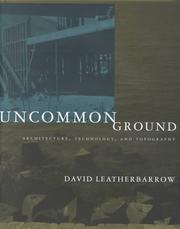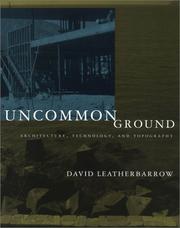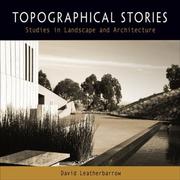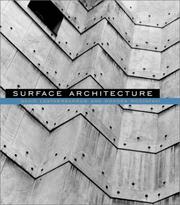| Listing 1 - 10 of 23 | << page >> |
Sort by
|
Book
ISBN: 9781568988115 1568988117 Year: 2009 Publisher: New York, N.Y. Princeton Architectural Press
Abstract | Keywords | Export | Availability | Bookmark
 Loading...
Loading...Choose an application
- Reference Manager
- EndNote
- RefWorks (Direct export to RefWorks)
architectuur --- Architecture --- cultuurfilosofie --- architecture [discipline] --- Philosophy and psychology of culture --- Philosophy. --- Philosophie --- Philosophy --- architectuurfilosofie

ISBN: 0262122308 9780262122306 Year: 2000 Publisher: Cambridge, Mass. The MIT press
Abstract | Keywords | Export | Availability | Bookmark
 Loading...
Loading...Choose an application
- Reference Manager
- EndNote
- RefWorks (Direct export to RefWorks)
technology --- Engineering sciences. Technology --- Geography --- Architecture --- architectural theory --- topography [image-making] --- Neutra, Richard --- Konstantinidis, Aris --- Raymond, Antonin --- Building sites --- Architecture and technology --- Planning --- Environmental aspects --- Neutra, Richard Joseph, --- Raymond, Antonin, --- Konstantinides, Ares, --- Criticism and interpretation --- technology [general associated concept] --- Neutra, Richard Joseph, - 1892-1970 --- Raymond, Antonin, - 1888 --- -Konstantinides, Ares, - 1913 --- -Engineering sciences. Technology

ISBN: 0262621614 Year: 2002 Publisher: Cambridge London MIT Press
Abstract | Keywords | Export | Availability | Bookmark
 Loading...
Loading...Choose an application
- Reference Manager
- EndNote
- RefWorks (Direct export to RefWorks)
Building sites --- Architecture and technology --- Architecture --- Architecture, Modern --- Chantiers de construction --- Architecture et technologie --- Planning --- Environmental aspects --- Planification --- Aspect de l'environnement --- Neutra, Richard Joseph, --- Raymond, Antonin, --- K*onstantinid*es, Ar*es, --- Architecture and technology. --- Planning. --- Environmental aspects. --- Neutra, Richard, --- Kōnstantinidēs, Arēs, --- Criticism and interpretation.
Book
ISBN: 0521442656 Year: 1993 Publisher: Cambridge Cambridge University Press
Abstract | Keywords | Export | Availability | Bookmark
 Loading...
Loading...Choose an application
- Reference Manager
- EndNote
- RefWorks (Direct export to RefWorks)
Architectural design. --- Building materials. --- Building sites --- Planning.

ISBN: 0262278049 1423725247 9780262278041 9780262338547 0262338548 9780262122306 9781423725244 0262122308 Year: 2000 Publisher: Cambridge, Mass. : MIT Press,
Abstract | Keywords | Export | Availability | Bookmark
 Loading...
Loading...Choose an application
- Reference Manager
- EndNote
- RefWorks (Direct export to RefWorks)
How building and site, technology and topography, interact to create successful buildings and resolve theoretical issues in practice.Although both are central to architecture, siting and construction are often treated as separate domains. In Uncommon Ground, David Leatherbarrow illuminates their relationship, focusing on the years between 1930 and 1960, when utopian ideas about the role of technology in building gave way to an awareness of its disruptive impact on cities and culture. He examines the work of three architects, Richard Neutra, Antonin Raymond, and Aris Konstantinidis, who practiced in the United States, Japan, and Greece respectively.Leatherbarrow rejects the assumption that buildings of the modern period, particularly those that used the latest technology, were designed without regard to their surroundings. Although the prefabricated elements used in the buildings were designed independent of siting considerations, architects used these elements to modulate the environment. Leatherbarrow shows how the role of walls, the traditional element of architectural definition and platform partition, became less significant than that of the platforms themselves, the floors, ceilings, and intermediate levels. He shows how frontality was replaced by the building's four-sided extension into its surroundings, resulting in frontal configurations previously characteristic of the back. Arguing that the boundary between inside and outside was radically redefined, Leatherbarrow challenges cherished notions about the autonomy of the architectural object and about regional coherence. Modern architectural topography, he suggests, is an interplay of buildings, landscapes, and cities, as well as the humans who use them. The conflict between technological progress and cultural continuity, Leatherbarrow claims, exists only in theory, not in the real world of architecture. He argues that the act of building is not a matter of restoring regional identity by re-creating familiar signs, but of incorporating construction into the process of topography's perpetual becoming.
Building sites --- Architecture and technology --- Architecture --- Art, Architecture & Applied Arts --- Planning --- Environmental aspects --- Architecture, Western (Western countries) --- Building design --- Buildings --- Construction --- Western architecture (Western countries) --- Technology and architecture --- Site planning --- Design and construction --- Art --- Building --- Technology --- Architecture and technology. --- Planning. --- Environmental aspects. --- Neutra, Richard Joseph, --- Raymond, Antonin, --- Kōnstantinidēs, Arēs, --- Criticism and interpretation. --- ARCHITECTURE/Architectural History/Modern Architecture --- Konstantinidis, Aris, --- Konsztantinidisz, Arisz, --- Κωνσταντινίδης, Αρης, --- Rajman, Antonin, --- Neutra, Richard, --- Neutra, Richard --- Neutra, Richard J. --- Building sites - Planning --- Architecture - Environmental aspects --- Neutra, Richard Joseph, - 1892-1970 - Criticism and interpretation --- Raymond, Antonin, - 1888- - Criticism and interpretation --- Konstantinides, Ares, - 1913- - Criticism and interpretation
Book
ISBN: 9780812223507 0812223500 Year: 2004 Publisher: Philadelphia University of Pennsylvania Press
Abstract | Keywords | Export | Availability | Bookmark
 Loading...
Loading...Choose an application
- Reference Manager
- EndNote
- RefWorks (Direct export to RefWorks)
"My aim ... is to describe the ways that the two disciplines, landscape architecture and architecture, contribute to the formation of a single cultural framework, topography" -- Introduction.
Topografie --- Historische tuinen --- Architectuur --- Landschapsarchitectuur --- Architecture. --- Design. --- Landscape architecture.
Book
ISBN: 9781350165182 1350165190 9781350165199 Year: 2021 Publisher: London Bloomsbury Visual Arts
Abstract | Keywords | Export | Availability | Bookmark
 Loading...
Loading...Choose an application
- Reference Manager
- EndNote
- RefWorks (Direct export to RefWorks)
"While most books on architecture concentrate on spatial themes, this book explores architecture's temporal dimensions. Through a series of close readings of buildings, both contemporary and classic, it demonstrates the centrality of time in modern architecture, and shows why an understanding of time is critical to understanding good architecture. All buildings exist in time. Even if designed for permanence, they change, slowly but inevitably. They change use, they accrue history and meaning, they decay - all of these processes are inscribed in time. So too is the path traced by the sun through a building, and the movements of the human body from room to room. Time, this book argues, is the framework for our spatial experience of architecture, and a key dimension of a building's structure and significance. Building Time presents twelve close readings of buildings and artworks which explore this idea. Examining works by distinctive modern architects - from Eileen Gray to Álvaro Siza and Wang Shu - it takes the reader, in some cases literally step-by-step, through a built work, and provides insightful reflections on the importance of 'making space for time' in architectural design. This is a book for both theorists and for architectural designers. Through it, theorists will find a way to rethink the fundamental premises and aims of design work, while designers will rediscover the order and ideas that shape the world around them-its buildings, interiors, and landscapes."--
Architectural design --- Architecture --- 72.01 --- Design --- Structural design --- 72.01 Architectuurtheorie. Bouwprincipes. Esthetica van de bouwkunst. Filosofie van de bouwkunst --- Architectuurtheorie. Bouwprincipes. Esthetica van de bouwkunst. Filosofie van de bouwkunst --- 72.01 Theory and philosophy of architecture. Principles of design, proportion, optical effect --- Theory and philosophy of architecture. Principles of design, proportion, optical effect --- Philosophy --- Environmental aspects --- Time --- Philosophy. --- Environmental aspects. --- Social aspects.

ISBN: 0812238095 Year: 2004 Publisher: Philadelphia (Pa) University of Pennsylvania Press
Abstract | Keywords | Export | Availability | Bookmark
 Loading...
Loading...Choose an application
- Reference Manager
- EndNote
- RefWorks (Direct export to RefWorks)
Book
ISBN: 1350165212 1350165220 1350165204 Year: 2020 Publisher: London [England] : [London, England] : Bloomsbury Visual Arts, Bloomsbury Publishing,
Abstract | Keywords | Export | Availability | Bookmark
 Loading...
Loading...Choose an application
- Reference Manager
- EndNote
- RefWorks (Direct export to RefWorks)
"While most books on architecture concentrate on spatial themes, this book explores architecture's temporal dimensions. Through a series of close readings of buildings, both contemporary and classic, it demonstrates the centrality of time in modern architecture, and shows why an understanding of time is critical to understanding good architecture. All buildings exist in time. Even if designed for permanence, they change, slowly but inevitably. They change use, they accrue history and meaning, they decay - all of these processes are inscribed in time. So too is the path traced by the sun through a building, and the movements of the human body from room to room. Time, this book argues, is the framework for our spatial experience of architecture, and a key dimension of a building's structure and significance. Building Time presents twelve close readings of buildings and artworks which explore this idea. Examining works by distinctive modern architects - from Eileen Gray to Álvaro Siza and Wang Shu - it takes the reader, in some cases literally step-by-step, through a built work, and provides insightful reflections on the importance of 'making space for time' in architectural design. This is a book for both theorists and for architectural designers. Through it, theorists will find a way to rethink the fundamental premises and aims of design work, while designers will rediscover the order and ideas that shape the world around them-its buildings, interiors, and landscapes."--
Architectural design --- Architecture --- Philosophy. --- Environmental aspects.

ISBN: 0262134071 9780262621946 9780262134071 Year: 2002 Publisher: Cambridge (Mass.) MIT Press
Abstract | Keywords | Export | Availability | Bookmark
 Loading...
Loading...Choose an application
- Reference Manager
- EndNote
- RefWorks (Direct export to RefWorks)
Visually, many contemporary buildings either reflect their systems of production or recollect earlier styles and motifs. This text explores ways that design can take advantage of production methods so that architecture is neither independent of nor dominated by technology.
692.2 --- 692 --- 691 --- Buitenmuren --- Gevels --- Muren --- Constructiedelen --- Bouwmaterialen (architectuur) --- Architecture --- Architecture and technology --- Materials --- Appearance --- Architecture and technology. --- Architecture. --- Appearance. --- Architecture et technologie --- Matériaux --- Appearence --- Apparence --- Appearance of materials --- Technology and architecture --- Technology --- Architecture, Western (Western countries) --- Building design --- Buildings --- Construction --- Western architecture (Western countries) --- Art --- Building --- Design and construction --- Architecture, Primitive --- Materials - Appearance
| Listing 1 - 10 of 23 | << page >> |
Sort by
|

 Search
Search Feedback
Feedback About UniCat
About UniCat  Help
Help News
News